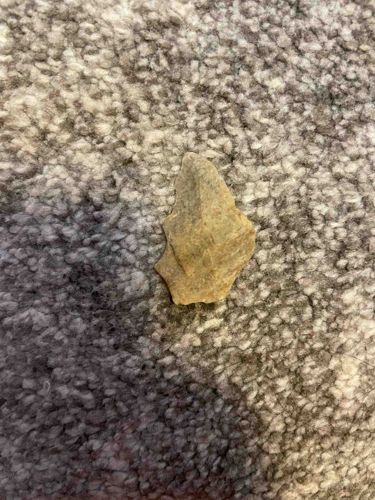
Stone Projectile Point Fragment
The item appears to be a stone projectile point, commonly known as an arrowhead or spearhead fragment, crafted from a light brown to tan colored chert or flint. Its physical characteristics indicate it is a lithic artifact, shaped through knapping. The visible portion is roughly triangular with irregular edges, suggesting a broken base or blade, or possibly an unfinished piece. It is relatively small, consistent with an arrowhead, though its exact dimensions are difficult to ascertain without a scale. The surface exhibits a natural, dull finish, typical of weathered stone, and there are visible fracture patterns from the flint-knapping process. No explicit maker's marks or signatures are discernable. The condition appears to be stable, with no obvious signs of recent damage beyond the implied breakage; however, natural wear and patina from age and exposure are evident. The craftsmanship, while appearing crude to an untrained eye, shows the distinct flaking patterns indicative of human modification for tool use. The material itself seems fine-grained enough to hold a sharp edge, though the edges visible are not razor-sharp, possibly due to erosion or incidental breakage. Given its form and material, it most likely dates from a prehistoric period, potentially thousands of years old.
AI-Generated Appraisal Disclaimer
Estimated Value
$25-50
Basic Information
Category
Archaeological Artifact
Appraised On
November 28, 2025
Estimated Value
$25-50
Item Description
The item appears to be a stone projectile point, commonly known as an arrowhead or spearhead fragment, crafted from a light brown to tan colored chert or flint. Its physical characteristics indicate it is a lithic artifact, shaped through knapping. The visible portion is roughly triangular with irregular edges, suggesting a broken base or blade, or possibly an unfinished piece. It is relatively small, consistent with an arrowhead, though its exact dimensions are difficult to ascertain without a scale. The surface exhibits a natural, dull finish, typical of weathered stone, and there are visible fracture patterns from the flint-knapping process. No explicit maker's marks or signatures are discernable. The condition appears to be stable, with no obvious signs of recent damage beyond the implied breakage; however, natural wear and patina from age and exposure are evident. The craftsmanship, while appearing crude to an untrained eye, shows the distinct flaking patterns indicative of human modification for tool use. The material itself seems fine-grained enough to hold a sharp edge, though the edges visible are not razor-sharp, possibly due to erosion or incidental breakage. Given its form and material, it most likely dates from a prehistoric period, potentially thousands of years old.
Get Your Items Appraised
Instant estimates of your treasures with AI-powered instant appraisals